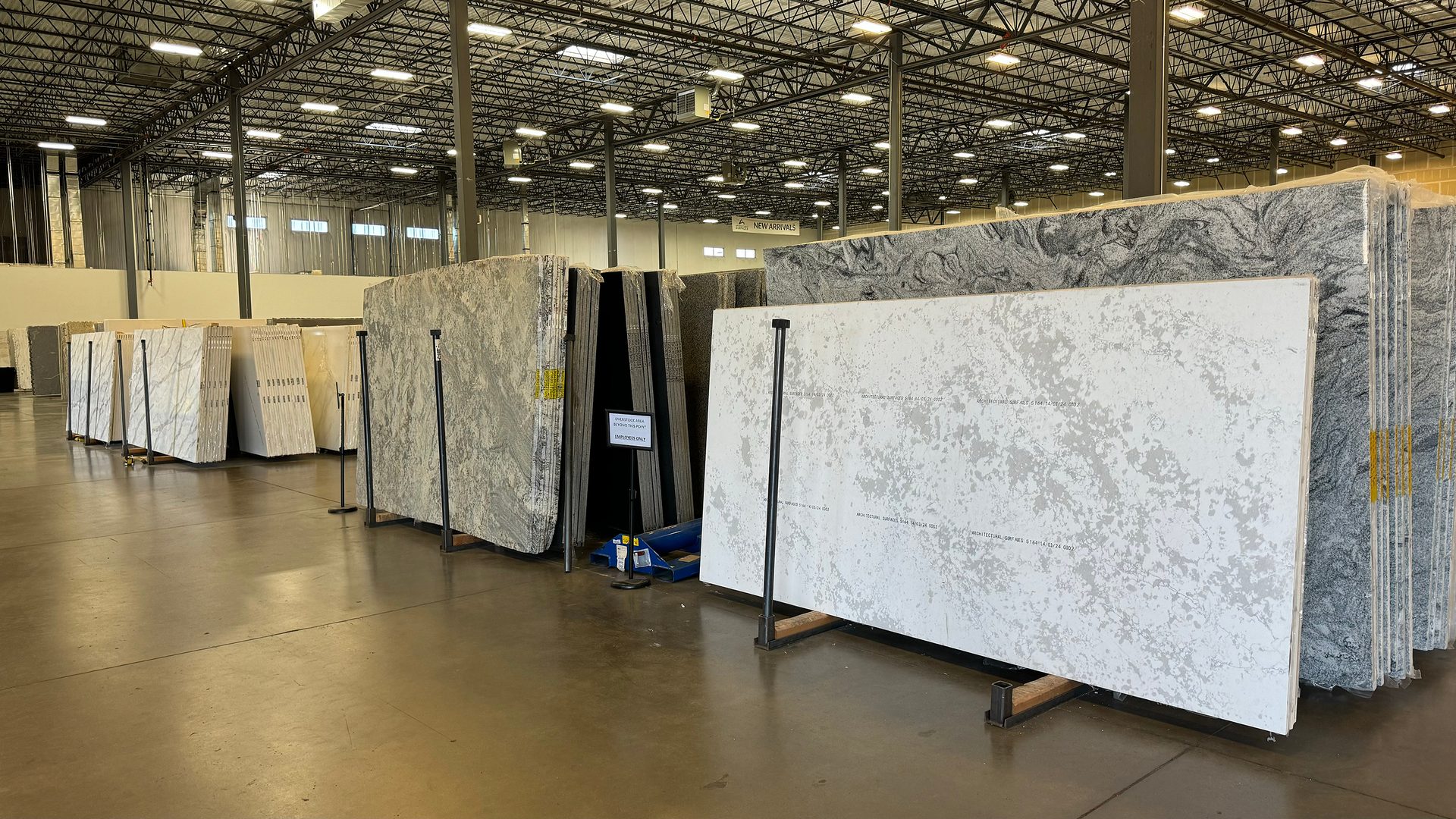Fabricators Weigh in on Quartzite
Photo Credit: Patagonia Vitrum/Courtesy of Antolini
?
by Jennifer Richinelli
With many customers seeking a luxurious statement piece for their kitchen designs, quartzite remains a favorite among material choices in markets across North America. To complete a successful job, there is a great deal for fabricators to take into consideration. Stone World had the opportunity to ask several fabricators from diverse areas across the U.S. to share their experiences working with quartzite.
- Miranda Falloon — Stellar Stone Works; Bourbon, MO
- Tanya Fischbeck — G3 Glass Granite Group; Mesa, AZ
- Jeff Ford — Ford Stone; Rockford, MI
Rod Sigman CTC, CCTS, CSMTT is the business development leader for MAPEI Corporation’s UltraCare® line of products for the care and maintenance of tile and stone products. Sigman has a proven track-record of success in the flooring industry, with experience in both training and education, as well as all support functions pertaining to national sales accounts and distribution. He has served on the technical committees of the National Tile Contractors Association (NTCA) and the Natural Stone Institute (NSI). He has successfully completed the Ceramic Tile Consultant Course, is a Certified Ceramic Tile Specialist (CCTS) and is also a Concrete Slab Moisture Testing (CSMT) Technician. Further, he was recognized by the Marble Institute of America (now the Natural Stone Institute) as a significant influence for the stone industry.
SW: Do you find quartzite is in high in demand in your market?
MF: It is becoming more popular each month.
TF: Yes
JF: Quartzite is very popular in my area.
SW: What percentage of your business does it comprise?
MF: Currently, it is about 10% of our business. We cut a large quantity of quartz and granite product as well.
TF: 50%
JF: It makes up about 30% of my projects.
SW: Do you find you have to educate your customers on the material, and if so, what are some points of consideration that you discuss with them?
MF: We make sure they understand that while quartzite is typically lower maintenance than some other natural stones, it is more prone to staining and water marks. Spills should be cleaned up promptly and regular sealing is recommended.
TF: Yes. “White” quartzites such as Mont Blanc are most likely dolomites and will retain water, etch and stain much like marble. Taj Mahal is our go-to. It’s much whiter than gold/orange from decades ago and it goes with any style -- from modern to rustic to traditional. Real quartzite is the hardest stone and recommended for its durability and beauty.
JF: I try to educate each customer on the care of the product we install.
As far as the quartzite is concerned, the huge education has been for myself and our team on how to address sealing it and making sure that moisture does not enter the product. By the time we get the material to the customer, we should only have to explain to them how to care for it, and that they should use it like any other countertop they have had in the past.
Some of the issues that we have with many of our natural stones are the fact that they put resins in all of them to seal up cracks and fishers. This creates the use of stone countertops to be more like a laminate countertop. Meaning, no heat or not to cut on them, because the heat will affect the resins and the resins can be scratched as they are not durable as the material itself.
SW: Are there any challenges that you find when working with quartzite?
MF: Yes, water retention is our largest challenge. Some quartzites have no water retention, and others take days, or weeks to dry out. That is even with pre-sealing the slab before cutting. The drying process can consist of just putting in front of a fan, or resorting to using a dry room with dehumidifier.
TF: On all quartzites, we use special blades that cost more, and we run our saws slower. This adds time and expense to fabrication, but these details are addressed upfront with our customers. We have had moisture retention on seams and around faucet holes, aka bleeding or staining. It isn’t always noticeable upon installation and can “gray” the veins weeks and even months after installation. We take precautions to seal prior to cutting and fabricating, which reduces the instances; however, we do educate our clients upon the possibility of this happening. One way to dry this out is to use a mixture of baking soda or diatomaceous earth and acetone. Mix to create a texture similar to pancake batter. Pour over the shaded area, with a 1/2-inch overlap onto either side. Cover with plastic and secure with blue tape. Allow to sit for 12 hours, and repeat as needed. This process may take several applications for the bleeding to dry out. It is also recommended to open cabinet doors, and if a fan is available, turn it on to help dry it out from the underside
JF: There are many challenges to working with quartzite. I believe some of the biggest challenges are the mislabeling of materials. Quartzite is sand- or sugar-like before it turns into a true quartz. A true quartz is extremely hard and would handle heat as well as knives. We would not have nearly the issues that I see fabricators having if everything was a true quartzite. Many of the materials are mislabeled. They have not spent enough time in the ground to truly become a quartzite. This is why we have so many problems with water and oil absorption in these materials. They are sugar like before. They are as hard as quartz, and when they are grainy like sugar, they are like a sponge. And because the slabs are resin-coated on the top and the bottom, it makes it very tricky to get sealer everywhere to keep moisture from getting deep into the material. This is also why it takes so long for them to dry after they have been processed by fabricators.
SW: How often do you receive callbacks from customers with quartzite countertops?
MF: The only callbacks we have received are for water retention that has become prevalent after install. Of course, the material did not show any signs of water retention at install. These types of callbacks have been minimal, but tend to be the same colors.
TF: We really don’t have callbacks on quartzite. In the event there is a moisture retention problem, they have been rectified with the paste solution.
JF: We don’t receive many callbacks for any of the products we install. I do catch a lot of grief from customers as why their tops are taking so long for them to receive. This is due to the fact of drying time, as well as the number of coats of sealers and the additional areas where we seal the materials to keep moisture from entering the stone. I believe it’s how we seal or not seal the material well enough that cause us callbacks.
These materials that they label as quartzite need to be treated like the waterproofing of a shower. If there’s any place that wasn’t sealed, the water will find it. I believe most fabricators are having trouble because they are not sealing the material as well as it needs to be. The manufacturers of sealers are trying to come up with better products, as well as techniques to assist us. They need to penetrate the fishers that are in the resin coating, and as fabricators, we need to seal under the dishwasher all the back edges, many inches back on the front edge, as well as the sink cut out edges, faucet holes and anywhere else water can possibly get. Water will work around the edge of the countertop underneath the backsplash and into the back edge, and the material will suck it up from the bottom like a sponge.
SW: When it comes to fabricating quartzite are there any tooling/machines or techniques you find work best?
MF: We use saw blades and tooling made specifically for quartzite.
TF: Diamonds aren’t just a girl’s best friend. They are quartzites too! Quartzite blades have more diamonds, and it takes more time to cut.
JF: On the CNC machine, we use the same tooling that we cut every material with, but we adjust our feed rates and the amount of material that is taken off per pass on the machine. For the sawblades, I have used some of my porcelain blades for the true quartzites like a Taj Mahal, but for most of the other mislabed materials as quartzite I use my general purpose granite and quartz blade. This is what has worked for us.
SW: How does installing quartzite compare to installing other materials?
MF: Installation is similar to other materials, except it can be heavier. If the quartzite has a lot of natural fissures, it may require extra bracing and support for transport to the jobsite.
TF: With all materials, we take into consideration the weight, the size and the obstacles to navigate when installing. Having a strong handle and open communication regarding the construction site is critical to a smooth and safe installation. We prioritize knowing all access restraints prior to rolling our trucks, as these slabs are extremely heavy and our install crews must have a gameplan prior to arriving on site. If parking is shared by other trades, concrete has yet to be poured, there are stairs to climb or small children or pets on site, we identify and address these potential hazards. Our laser templating and shop fabrication eliminate the need for excessive adjustments onsite -- keeping dust to a minimum and our worksite neat and orderly.
JF: The only big change that we do is the glue we use for the seaming application. We use a non-bleeding glue. The non-bleeding glue that works best for us is a urethane-based glue.
SW: Is there anything else you’d like to share about working with quartzite?
TF: Quartzite is one of our favorite stones to work with, and one that we recommend with confidence. It is not only loved for its beauty, but for its durability, resistance to chipping, staining, scratching and heat. It’s a natural stone that’s great for both indoors and outdoors, and is perfect for its aesthetic design that blends with any style.
JF: I’m not sure I have anything else to add as far as using quartzite for countertops. Because of the nature of the quartzite and its hardness when it’s labeled correctly, it’s an amazing material. Because of the hardness, you may find fishers and or cracks. Because of this, you have to handle the material like a delicate marble with a fair amount of reinforcement. The cracks and fishers act a bit like dry veins and some marble materials that seem like they can fall apart when you were looking at them wrong. It’s like any natural stone. We need to expect the unexpected if we don’t want any trouble, and even then, sometimes we have trouble.

